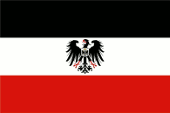Kiautschou |
|
|
|
| Übersicht – Contents: | |
Diese Seite ist Teil des Projektes
Kiautschou |
|
|
|
| Übersicht – Contents: | |
Flaggen – Flags: |
|
 |
1893–1914, |
 |
1898–1914, |
 |
1898–1914, Flagge des Gouverneurs der Kolonie Kiautschou – flag of the Governor of the Kiaochow colony, Seitenverhältnis – ratio = 2:3, Quelle/Source: Die Welt der Flaggen |
|
|
|
Bedeutung/Ursprung der Flagge – Meaning/Origin of the Flag: |
|
| Kiautschou war keine Kolonie im üblichen Sinne, die wie meist sonst aus kaufmännischen Interessen und Kolonialgesellschaften heraus entstanden ist. Das Gebiet wurde 1897 wegen zwei in der Umgebung ermordeter katholischer deutscher Missionare durch Marineinfanterie besetzt. Es diente als Hafen für das deutsche Ostasiengeschwader und unterstand einem der Gouverneur, der dem Reichsmarineamt unterstellt war. Darum wehte hier an offizieller Stelle nicht die Flagge des Kolonialamtes, sondern die Dienstflagge der Marine des Deutschen Reiches. Der Gouverneur hatte eine eigene Flagge, eine Besonderheit, die sonst nur in Deutsch-Ostafrika vorgekommen ist. |
Kiaochow was not a colony in the usual sense, which is – like most other –
developed out from commercial interests and colonial societies. The area was
occupied in 1897 by naval infantry because of two murdered German Catholic
missionaries in the area. It served as a haven for the German East Asia Squadron and was subordinated ander a governor, who was assumed to the Admiralty. That's why here did not fly the flag of the Colonial Office for offizial purpose, but the official flag of the navy of the German Empire. The governor had his own flag, a specialty, that otherwise occurred only in German East Africa. |
| Quelle/Source: Deutsches Koloniallexikon, Deutsche Kolonien, Volker Preuß | |
| Lage von Kiautschou – position of Kiaochow: |
|
 Zum Vergrößern anklicken. Quelle: Herrmann Julius Meyer, Public domain, via Wikimedia Commons |
Zahlen und Fakten – Numbers and Facts: |
|
|
|
|
|
|
|
|
|
|
|
|
|
Geschichte: |
|
1897
· auf der Halbinsel Schantung werden zwei katholische deutsche Missionare
ermordet 14.11.1897 · Das Deutsche Reich besetzt die Bucht von Tsingtau und errichtet ein Schutzgebiet 06.03.1898 · Kiautschou-Vertrag mit China, Abtretung der Tsingtau-Bucht per Pachtvertrag an das Deutsche Reich, Errichtung einer 50 km tiefen neutralen Zone um die Kolonie, Status der Provinz Schantung als Einflussgebiet 16.08.1914 · Japan fordert nach Beginn des Ersten Weltkrieges die Herausgabe der Kolonie, und beginnt wenig später mit der Belagerung 07.11.1914 · die 4000 Verteidiger der Kolonie, darunter 2400 reguläre Soldaten kapitulieren nach neun Tagen Beschuss, Kiautschou wird von Japan besetzt 06.02.1922 · auf Druck der Alliierten muss Japan Kiautschou an China zurückgeben |
History: |
|
1897
· on Shantung peninsula two German Catholic missionaries become killed 14th of November 1897 · The German Empire occupies the Bay of Qingdao and establishes a protectorate 6th of March 1898 · Kiaochow Treaty with China, China cedes Qingdao Bay to the German Empire by leasehold, establishment of a 50 km deep neutral zone around the colony, status of the province of Shantung as a sphere of influence 16th of August 1914 · Japan claims after the start of the First World War, the surrender of the colony, and shortly thereafter begins with the siege 7th of November 1914 · the 4000 defenders of the colony, including 2400 regular soldiers, surrender after nine days of bombardment, Kiaochow becomes occupied by Japan 6th of February 1922 · after pressure of the Allies Japan must return Kiaochow to China |
| Quelle/Source: Deutsches Koloniallexikon, Deutsche Kolonien |
Ursprung des Landesnamens – Origin of the Country's Name: |
|
| Der Name "Kiautschou" bezieht sich auf die Kiautschou-Bucht, die komplett zum Territorium der Kolonie gehörte. Der Name der Bucht geht auf die 45 km entfernte Stadt Jiaozhou zurück. "Jiaozhou" heißt "Leimstadt". | The name "Kiaochow" refers to the Kiaochow Bay, which belonged entirely to the territory of the colony. The name of the bay goes back to the 17 miles from the bay placed City of Jiaozhou. "Jiaozhou" means "Glue City". |
| Quelle/Source: Deutsches Koloniallexikon | |